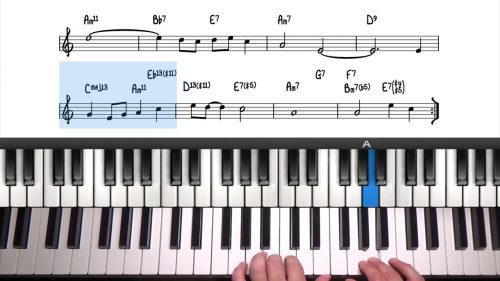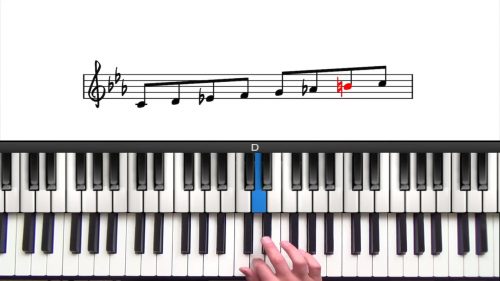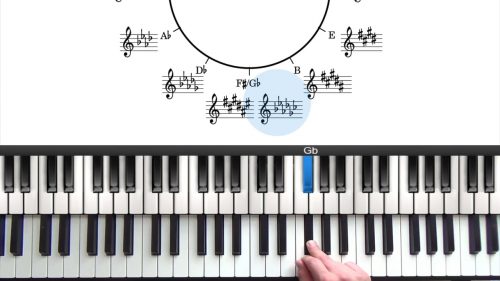Transposing For The Jazz Musician
In this lesson, we’ll learn the basics of quick transposition. Transposition is the process of taking a tune in a certain key such as Amin and transposing, or changing it to another, such as Cmin.
Let’s use Summertime to demonstrate since it’s wildly popular with singers.
We’ll break down the process into 6 easy steps. But before we do, let’s talk about why it’s an important skill to have, as an accompanying pianist.
Finding The Right Key For The Singer
It’s important to get the right key for any given song when working with the voice. While it’s preferred to sing a song in the original key, especially for jazz jams settings, the reality is that the original key will not work for every song.
It’s more professional to find where the song does fit better in a particular voice to bring out the best tone and interpretation possible. The melody must suit the range of the singer and so finding that right key is part of the art form that must be mastered as a singer.
Simplify The Chord Changes
The first step is to simplify the chord changes. Take the most simple version of the harmony and this will work fine for deciphering a key. And once the key is determined, and you are working with your singer, you can add back all the complexity you want.
Analyse The Chords Numerically
By analysing the chords numerically, you will get the ‘blue print’ to transpose into any key… considering that you know your major and minor scales! We work through the whole form to establish the functional harmony.
Transpose The Melody
When working with a singer, you only need to analyse the first few notes of the melody, to get the singer rolling in the new key. Always analyze the first few notes in relation to the starting chord, which is also my tonality in the case of Summertime. Keeping track of this is important as we try out different keys.
Lesson Downloads
-
How To Transpose Jazz Standards File Type: pdf
Practice Tips
-
This 6 step process can be repeated as many times as needed for the singer to find the right key.
-
If the singer is having trouble switching from one key to the next, then you can always transpose more of the melody.
-
Sometimes just moving up a half step makes a big difference, so going up a half step or whole step in either direction is good practice for working with a singer.
-
If you are the singer, try it out in different keys and see which one feels best. Often it's very obvious that right fit, but other times you might want to try it out a few different days, and see if one stands out.
-
When just starting out with transposition, it's a good idea to write everything out as we did. But over time, it becomes 2nd nature and you won't' need to write it down.








Thank you Lyndol and Hayden. The use of Roman numerals is eminently sensible and of course, tests our knowledge of the major and minor scales. I will have a go at transposing Misty and Tenderly for extra practice :)
How do i know where chest voice starts and ends ?The same question goes for head voice.This for all types of coices like bass barítone alto tenor etc.
Hi Ivan – Good question – here is Lyndol’s response:
The range of the chest voice, and head voice is different for each singer. But generally speaking – it happens just above middle C, where you go from Chest to Head.
To test it for yourself, you can start low and sing each note on the piano in half steps on La or Oh – try to stay in your chest voice as long as you can. There will be a point where your voice flips automatically to head. That’s your break point.
You can do the same from the high notes, using your head voice and come down as low as you can go while still using your head voice. This is way to map out your own voice’s range.
There is a an area (typically) where the voices overlap and you can use either, Chest or Head. For me, it’s from G3 – B5. You should try this exercise for a few days in a row to get a consistent reading. If you are not able to control when you use head or chest, then this will not give you as accurate a map, but more of a general idea. And can start you on a path of being able to consciously choose which voice to use.
Other way to figure it out… You can just feel where the sound resonates. Chest voice are lower notes that vibrate strongly in your chest area, while the higher notes will vibrate in your head space for your head voice… hence the names.
This is a bit simplified for ease of explaining – since there are such things as blended voice (where you combine voices) and Belting (where you sing up very high using your chest voice) that might confuse the matter for the moment, but wanted to mention in case you are not sure which voice you are using – it could be one of these options as well.
Now to apply to alto, tenor, bass – the map of Chest and Head voices will be very similar in each group, but not exactly the same.
You can see a map of the average range of the groups are in the first lesson of the Accompanying Singer’s Course. pianogroove.com/jazz-piano-lessons/working-with-singers-tips/ @ 2:23 – But Each persons voice has it’s own particular range.
Hope this helps to answer your question.
Cheers,
Hayden
I sometimes accompany singers who are auditioning for musicals. They never show up with a lead sheet, but hand me an arrangement. Some of these arrangements (I.e. songs from Wicked, Sondheim shows, etc.) are too complicated for me to play without a lot of practice. To make it even more difficult, some songs don’t have chord symbols written in, so I can’t fake it. Analyzing and writing in the the chords takes too long as the director and singer are waiting. So I play the arrangement as best I can, but often can’t keep up and the singer messes up. Any suggestions?
Hi Kirk,
I can totally relate. Been in that situation quite a bit, and I can only offer a few suggestions.
#1 – The more you play off those charts, your sight reading skills will build. Are you practicing them at home?
There are tunes that are super common, so working on those in your practices will help prepare you for that work + get you closer to ease in sight reading off those kinds of charts.
I prefer lead sheets, but I’ve been forced to get decent at a lot of different formats such as 4 part voicings of hymnals. They all get easier with practice, though Broadway has been my least favorite sight reading due to the number of pages to turn. I’m not a super talented sight reader, but I have found that it’s possible to get good at any style chart with practice. I’ve also found you can loose ground on that skill if it’s not being utilized, just like a language.
#2 – In my experience, most of them do have the chord symbols, so I use those when I can. You can cheat them pretty well that way, and throw in the melody to keep the singer on track. I’ll try to play the intro from the notes on the page, then just keep the feel but with my own voicings from there.
#3 – When there are no chord symbols, don’t panic. It’s probably easier than it looks. If you look for a pattern, you can cheat it that way. You have every right to take a few minutes to look over the chart. Look for the key, chord progressions, note changes in key or tempo. Often, it’s possible to simplify the progression, leave out chords, and play only essential changes.
So just focus on the left hand; either note by note or just the 1st (and 3rd) beat.
Add in hints of the melody where you can, but especially at the start or beginning of new sections. Bass and Melody are the most essential elements a singer needs to stay on track.
After a page or two, you can probably start to see the chord progression from the left hand notes, so then you can add in simple right hand chords. This can sound like you’re building the arrangement as the song progresses. So it’s a way to learn the chart as you go which offer a build in sound that supports the singer’s performance.
#4 – Slow the tempo down if you need to. It’s not ideal, but more importantly – you want to play correct notes so this might be a necessary evil. It’s easier for you to deal with the chart at a slower pace.
#5 – Listen to your singer intently. There have been many times I’ve surprised myself by just staying relaxed and enjoying the experience. Your hands might know more than you think and your singer will perform better over relaxed accompaniment. Many of the chord progressions are the same, and the changes become intuitive if you can trust yourself.
#6 – I said it in #1, but worth repeating – work on all the popular songs ahead of time, even bring your own charts. You can look into getting ireal for Broadway standards, where you would at least have the chord changes + be able to change the key easily for the singer.
#7 – Don’t worry if you are not playing the chart exactly. Nobody expects perfection in those situations, when you haven’t rehearsed with the singer. But the fact that you care to accompany well – that goes a long way for the singer. Look for the musical connection and play from that place.
I think it’s great that you have this work and I know that you will have a steep learning curve. You’ll probably be proficient at sight reading Broadway or any chart before you know it. The more you make it part of your practice, the faster you’ll master it.
Best of luck, and let me know if you have further questions/comments.
– Lyndol
Thank you for the thoughtful reply. You’ve provided some very good tips that I will explore. Thank you so much.